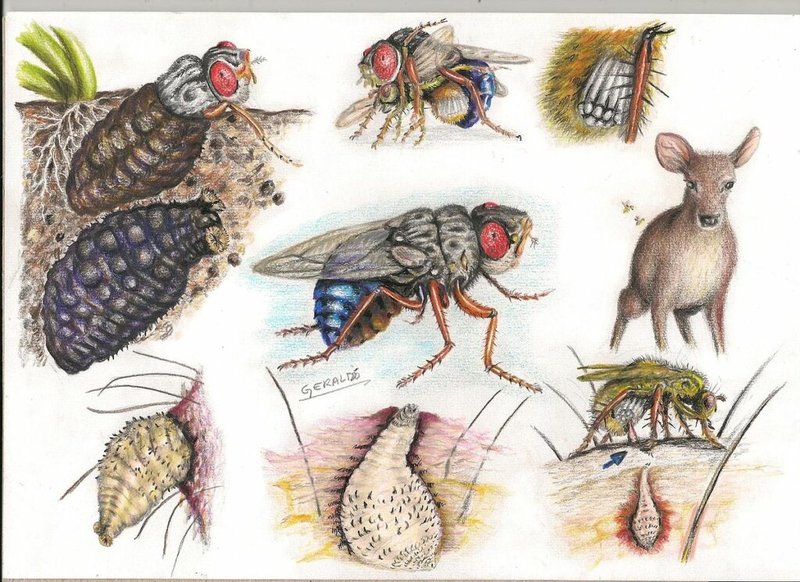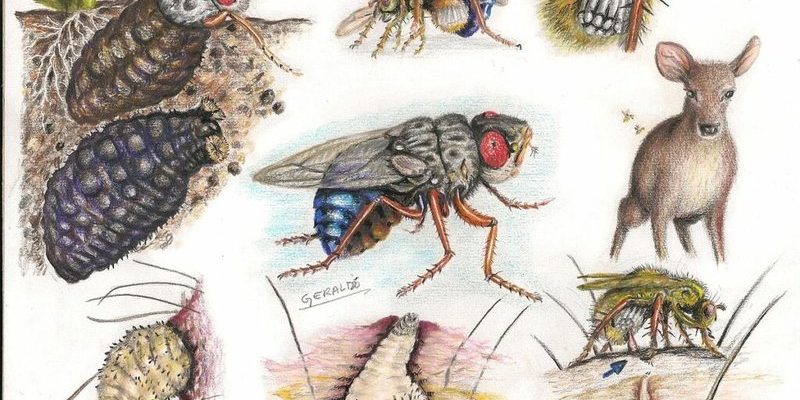
Imagine a wolf worm as a sort of nature’s hidden trickster. It starts its journey lurking inside the skin of a host animal. This can be a little unsettling, I know. It’s like a magician pulling a rabbit out of a hat—but in reverse! Instead of revealing something magical, the host gets to deal with a growing larval resident. Let’s take a moment to understand how this unusual life cycle plays out, shall we?
Understanding Wolf Worm Larvae
Wolf worm larvae, or *Cuterebra*, are the juvenile form of botflies that primarily parasitize mammals, often including our furry friends like rabbits and rodents. These larvae begin their life cycle when a female botfly lays her eggs near a host animal’s burrow or nest. When the eggs hatch, the larvae respond to the warmth and carbon dioxide that the host emits. It’s almost like a radar guiding them straight to their new home.
Once they find a host, the larvae burrow into the skin, creating a little tunnel just beneath the surface. This might sound alarming, but it’s all part of nature’s plan. Inside their cozy lodge, they’ll feed on the host’s tissues and fluids, growing larger as time passes. It’s a survival mechanism that has evolved over millions of years, with the larvae needing to rely on their host for energy.
You might be wondering how these little critters manage to thrive in such an environment. Well, they have developed some fascinating adaptations, like a tough outer layer that protects them from being attacked by the host’s immune system. This allows them to live undetected for weeks, sometimes even months!
The Life Cycle of Botflies
The life cycle of botflies is a remarkable journey that can be broken down into several stages: egg, larva, pupa, and adult. After the larvae spend enough time feeding and growing inside the host, they enter the next phase of their life cycle. When they’re ready to move on, they’ll create a little exit hole in the host’s skin and drop out into the world.
At this point, they’re still not adults yet. They’ll find a safe place in the environment, like dirt or leaf litter, to enter the pupation phase. Here, they wrap themselves in a protective casing, like an armored vehicle, where they transform into their adult form. This process can take anywhere from a few days to several weeks, depending on environmental conditions.
Once the pupation stage is complete, the adult botfly emerges. This is when the dramatic transformation occurs. They’re now equipped with all the features they need to thrive as adults—shiny bodies, functional wings, and a penchant for seeking out new hosts for reproduction. Their journey continues, and the cycle begins anew.
Challenges During Transition
Transitioning from a wolf worm larva to an adult botfly isn’t without its challenges. For starters, the larvae must survive the host’s defenses during their time inside. If the host becomes aware of them, it may try to remove them, leading to possible injury or death for the larvae. You might think of it as trying to navigate through a minefield, where one wrong move could be catastrophic.
Additionally, when larvae exit their host, they face the dangers of the outside world. They’re vulnerable to predators and environmental factors. If they can’t find a safe spot to pupate quickly, they risk being eaten or desiccated by the sun. Those that do find a safe place might also deal with competition from other larvae or species trying to occupy the same space.
It’s all part of the harsh reality in nature. Only a small percentage of larvae actually make it to adulthood, which is why their lifecycles are so fascinating and why they play such an important role in the ecosystem.
Why Do Botflies Matter?
You might be asking yourself, “Why should I care about the life cycle of botflies?” Well, these creatures play a complex role in the ecosystem. They are a part of the food web, providing sustenance for other animals. Birds, rodents, and even some reptiles may hunt and eat botflies, helping maintain a balance in their habitats.
Moreover, studying these insects can provide insights into parasitism and host interactions. They help entomologists understand evolutionary adaptations and the dynamics of host-parasite relationships. This is particularly important in the context of conservation and managing wildlife health.
So, while botflies might not rank high on your list of favorite animals, their lifecycle has significant ecological implications that affect multiple species.
Preventing Botfly Infestation
It’s not just about understanding the transition; knowing how to prevent botfly infestations is crucial, especially for pet owners. If your furry friend spends time outdoors, keep an eye out for signs of botfly larvae. Common symptoms include swelling beneath the skin or visible holes.
Here are some preventive measures you can take:
- Keep your pets indoors as much as possible, especially during peak botfly activity seasons.
- Regularly inspect your pets for any unusual lumps or bumps.
- Consult with your veterinarian about preventive treatments, particularly if you live in areas where botfly infestations are common.
- Maintain a clean living environment to reduce the chances of attracting botflies and their potential hosts.
Taking these steps can help your pets stay safe and healthy while minimizing the interaction between botflies and potential hosts.
The transition from wolf worm larvae to adult botflies is a unique journey that highlights both the beauty and complexity of nature. From their parasitic beginnings to their emergence as adult flies, these creatures remind us of the delicate balance of life. Understanding their lifecycle helps us appreciate their role in the ecosystem and encourages us to protect our pets from potential infestations.
So, the next time you hear about botflies, remember their incredible journey—it’s a fascinating tale of survival, adaptation, and the circle of life. Just like a good cup of coffee, it’s all about the process, right?

